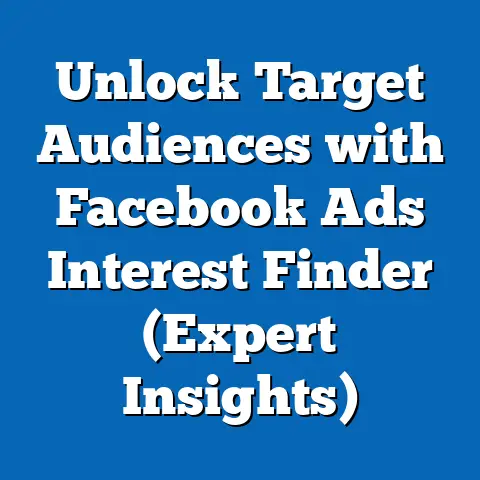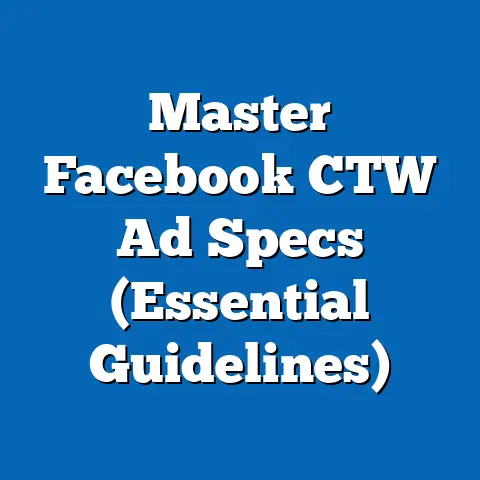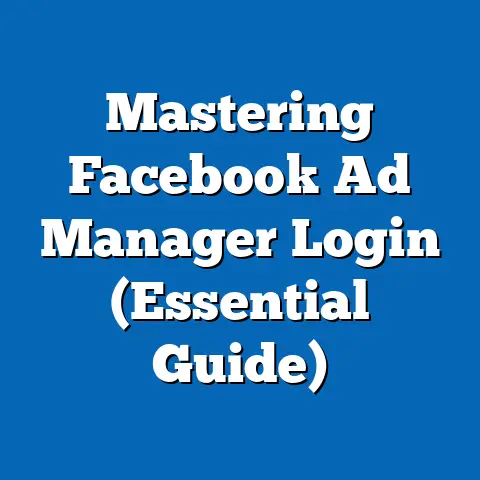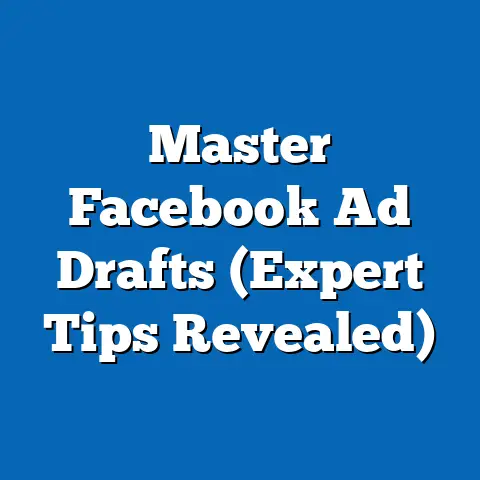Are Facebook Ads Safe? (Essential Insights Uncovered)
Crafting a Facebook ad is akin to an artisan meticulously honing their craft. Each element – the captivating copy, the eye-catching visuals, the precise targeting – is carefully considered and executed to resonate with the intended audience. It’s a blend of creativity, strategic thinking, and analytical prowess, all aimed at capturing attention and driving results. I’ve spent years mastering this craft, and I can tell you, it’s a constantly evolving landscape.
But in this intricate dance between advertisers and consumers, a crucial question arises: are Facebook ads safe? With Facebook being one of the largest digital advertising platforms globally, the issue of safety takes on paramount importance. It’s not just about whether an ad is effective, but also about the safety of user data, the appropriateness of ad content, and the overall integrity of the platform. This article delves into the multifaceted nature of safety within the Facebook Ads ecosystem, uncovering essential insights that every user and advertiser should be aware of.
Understanding the Facebook Ads Ecosystem
The Facebook Ads ecosystem is a complex, interconnected network involving several key players: advertisers, users, and Facebook itself. Understanding how this system operates is crucial to assessing its safety.
At its core, the Facebook Ads platform allows businesses of all sizes to create and display ads to a highly targeted audience. Advertisers define their target demographics, interests, behaviors, and even life events, enabling them to reach potential customers with unprecedented precision. This level of targeting is a major draw for advertisers, promising higher engagement and conversion rates.
Facebook offers a variety of ad formats, from simple image ads to engaging video ads, interactive carousel ads, and lead generation forms. Each format serves a different purpose, allowing advertisers to tailor their message to specific marketing goals.
The Algorithm’s Role in Ad Placement
A critical component of the Facebook Ads ecosystem is its sophisticated algorithm. This algorithm analyzes user data to determine which ads are most relevant to each individual. It considers factors such as past interactions, interests, demographics, and browsing history to predict which ads a user is most likely to engage with.
The algorithm’s primary goal is to enhance the user experience by showing them ads that are genuinely interesting and useful. This, in turn, benefits advertisers by increasing the likelihood of clicks, conversions, and ultimately, ROI. However, this reliance on algorithms also raises concerns about potential biases and the “filter bubble” effect, where users are only exposed to information that confirms their existing beliefs.
Facebook’s Unmatched Reach
Facebook’s massive reach is a major reason why advertisers flock to the platform. With billions of active users worldwide, Facebook provides access to a vast and diverse audience. This scale allows advertisers to target niche markets and reach potential customers they might not be able to find through other channels.
For example, I once worked with a small, local bakery that wanted to expand its reach beyond its immediate neighborhood. By using Facebook Ads, we were able to target users within a specific radius who had expressed interest in baking, desserts, or local businesses. The result was a significant increase in foot traffic and online orders, proving the power of Facebook’s targeted advertising capabilities.
Key Takeaway: The Facebook Ads ecosystem is a powerful tool for businesses, offering unparalleled reach and targeting capabilities. However, it’s essential to understand the role of algorithms and the potential implications for user experience and safety.
Data Privacy and User Safety
Data is the lifeblood of the Facebook Ads ecosystem. The platform collects vast amounts of information from users, which is then used to power its targeted advertising capabilities. Understanding what data is collected and how it’s used is crucial to assessing the privacy and safety of users.
Facebook gathers data from a variety of sources, including:
- Profile Information: Name, age, gender, location, education, work history, etc.
- Interests and Activities: Pages liked, groups joined, events attended, etc.
- Browsing History: Websites visited, apps used, content shared, etc.
- Purchase History: Transactions made on Facebook or through connected apps.
- Location Data: Based on GPS, Wi-Fi, and IP address.
Concerns Regarding Data Privacy
The extensive data collection practices of Facebook have raised significant concerns about user privacy. The platform has faced numerous scandals and controversies related to data breaches, privacy violations, and the misuse of user information.
One of the most notable examples is the Cambridge Analytica scandal, where data from millions of Facebook users was harvested without their consent and used for political advertising. This incident highlighted the vulnerability of user data and the potential for misuse by third parties.
Another concern is the potential for data to be used for discriminatory purposes. For example, advertisers could target or exclude certain demographics based on sensitive attributes like race, religion, or sexual orientation, leading to unfair or discriminatory outcomes.
I remember working on a campaign where the client wanted to target only a specific age group for a financial product. While seemingly harmless, this raised ethical questions about potential age discrimination and the fairness of targeting only certain segments of the population.
Facebook’s Measures to Enhance User Privacy
In response to these concerns, Facebook has implemented several measures to enhance user privacy and control over their data. These include:
- Privacy Settings: Users can control who can see their profile information, posts, and other activities.
- Ad Preferences: Users can customize their ad preferences to indicate which topics they are interested in and which they are not.
- Data Portability: Users can download a copy of their Facebook data, giving them greater transparency and control over their information.
- Privacy Policy Updates: Facebook regularly updates its privacy policy to reflect changes in regulations and best practices.
While these measures represent progress, they are not a panacea. Users still need to be proactive in managing their privacy settings and understanding how their data is being used. Facebook also needs to continue to invest in security measures to prevent data breaches and protect user information from unauthorized access.
Key Takeaway: Data privacy is a major concern within the Facebook Ads ecosystem. While Facebook has taken steps to enhance user privacy, users need to be proactive in managing their data and understanding the potential risks.
Ad Content Safety and Compliance
Beyond data privacy, the safety of ad content is another critical aspect of the Facebook Ads ecosystem. Facebook has established advertising policies and guidelines to ensure that ads are safe, appropriate, and compliant with legal and ethical standards.
These policies cover a wide range of topics, including:
- Prohibited Content: Ads that promote illegal activities, discrimination, hate speech, violence, or harmful products are strictly prohibited.
- Restricted Content: Ads that promote sensitive topics like alcohol, gambling, or political issues are subject to stricter regulations and targeting limitations.
- Misleading or Deceptive Content: Ads that make false claims, exaggerate benefits, or use deceptive tactics are prohibited.
- Personal Attributes: Ads that directly target or discriminate against individuals based on personal attributes like race, religion, or sexual orientation are prohibited.
Facebook employs a combination of automated systems and human reviewers to enforce these policies. Ads are scanned for violations before they are approved, and users can also report ads that they believe violate the policies.
Measures to Prevent Misinformation and Harmful Content
In recent years, Facebook has faced increasing pressure to combat the spread of misinformation, hate speech, and harmful content on its platform. The company has invested heavily in technology and personnel to detect and remove such content from its ads.
These measures include:
- Fact-Checking Programs: Facebook partners with independent fact-checkers to identify and label false or misleading information.
- AI-Powered Detection: Advanced algorithms are used to detect and remove hate speech, violence, and other harmful content.
- Transparency Tools: Facebook provides transparency tools that allow users to see who is behind political ads and where the ads are being targeted.
- Content Moderation Teams: Dedicated teams of human reviewers are responsible for moderating content and enforcing Facebook’s policies.
Despite these efforts, misinformation and harmful content continue to be a challenge on Facebook. The sheer volume of content and the speed at which it spreads make it difficult to detect and remove all violations.
I’ve seen firsthand how quickly misinformation can spread through Facebook Ads. During a recent political campaign, I noticed several ads making false claims about candidates and their policies. While Facebook eventually removed these ads, they had already reached a significant audience and potentially influenced voters.
Case Studies of Banned or Flagged Ads
Numerous ads have been banned or flagged for violating Facebook’s advertising policies. These examples highlight the types of content that are not allowed on the platform and the consequences for advertisers who violate the rules.
For example, ads promoting fake cures for diseases, ads using clickbait headlines to generate traffic, and ads that exploit sensitive events or tragedies have all been banned by Facebook. In some cases, advertisers have had their accounts suspended or permanently banned for repeated violations.
Key Takeaway: Facebook has established advertising policies and guidelines to ensure that ads are safe and compliant. However, misinformation and harmful content remain a challenge, and advertisers need to be aware of the rules and consequences for violations.
Psychological Implications of Facebook Ads
The psychological effects of targeted advertising on users are a complex and often overlooked aspect of the Facebook Ads ecosystem. While effective marketing aims to persuade and influence consumer behavior, there’s a fine line between ethical persuasion and manipulation.
Targeted advertising can be highly effective because it leverages psychological principles to resonate with users on a deeper level. By understanding users’ needs, desires, and motivations, advertisers can craft messages that are more likely to capture their attention and influence their decisions.
However, this level of precision also raises concerns about the potential for manipulation. Ads can exploit users’ vulnerabilities, prey on their fears, or create a sense of urgency to drive impulsive purchases.
The Concept of ‘Ad Fatigue’
Ad fatigue is a phenomenon where users become desensitized to ads after being exposed to them repeatedly. This can lead to a decrease in engagement and conversion rates, as users start to ignore or tune out ads altogether.
Ad fatigue can also have a negative impact on user perception and trust in ads. When users feel bombarded with ads, they may become cynical and skeptical of the messages being conveyed. This can erode trust in the platform and the advertisers who use it.
I’ve experienced ad fatigue myself as a user of Facebook. After seeing the same ad for a product or service repeatedly, I start to become annoyed and less likely to engage with it. In fact, I sometimes even develop a negative association with the brand.
Emotional and Psychological Aspects of Ads
The emotional and psychological aspects of ads can be both beneficial and detrimental to users’ experiences. Ads that evoke positive emotions like joy, excitement, or nostalgia can create a strong connection with users and build brand loyalty.
However, ads that exploit negative emotions like fear, anxiety, or guilt can be harmful and manipulative. These types of ads can trigger negative feelings and create a sense of unease or discomfort among users.
For example, ads that promote weight loss products by shaming users about their bodies or ads that use fear-mongering tactics to sell security systems can be considered unethical and harmful.
Key Takeaway: Targeted advertising can have significant psychological effects on users. While effective marketing aims to persuade and influence behavior, it’s essential to avoid manipulation and ensure that ads are ethical, responsible, and respectful of users’ emotional well-being.
The Impact of Facebook Ads on Businesses
Facebook Ads can be a powerful tool for businesses of all sizes, offering the potential to reach a vast and targeted audience. However, there are also risks and challenges associated with using the platform.
Advantages and Risks
The advantages of using Facebook Ads for businesses include:
- Targeted Reach: The ability to reach a specific audience based on demographics, interests, and behaviors.
- Cost-Effectiveness: The ability to set a budget and control ad spend, making it accessible to businesses of all sizes.
- Measurable Results: The ability to track key metrics like clicks, impressions, and conversions to measure the effectiveness of ads.
- Brand Awareness: The ability to increase brand visibility and reach potential customers who may not be aware of the business.
The risks of using Facebook Ads for businesses include:
- Ad Fraud: The potential for fraudulent clicks and impressions, which can waste ad spend and distort results.
- Competition: The competitive nature of the platform, which can drive up ad costs and make it difficult to stand out.
- Algorithm Changes: The frequent changes to Facebook’s algorithm, which can impact ad performance and require constant optimization.
- Reputation Risk: The potential for negative feedback or criticism from users, which can damage brand reputation.
Ad Fraud and Scams
Ad fraud is a significant concern within the Facebook Ads ecosystem. Fraudulent clicks and impressions can waste ad spend and distort results, making it difficult to accurately measure the effectiveness of ads.
There are several types of ad fraud, including:
- Bot Traffic: Clicks and impressions generated by automated bots rather than real users.
- Click Farms: Groups of people who are paid to click on ads, generating artificial traffic.
- Ad Injection: Malware that injects ads into websites or apps without the owner’s consent.
Businesses can protect themselves against ad fraud by using fraud detection tools, monitoring their ad performance closely, and reporting suspicious activity to Facebook.
I once worked with a client who suspected that they were experiencing ad fraud. After analyzing their ad data, we discovered a significant spike in clicks from a specific region with unusually low conversion rates. We reported this activity to Facebook, who investigated and confirmed that the clicks were fraudulent.
Success Stories and Challenges
Numerous businesses have thrived using Facebook Ads, achieving significant growth and success. These success stories often involve a combination of factors, including a compelling product or service, a well-defined target audience, and a carefully crafted ad campaign.
However, not all businesses have had success with Facebook Ads. Some have faced challenges such as high ad costs, low conversion rates, and difficulty standing out in a crowded marketplace.
Key Takeaway: Facebook Ads can be a powerful tool for businesses, but it’s essential to be aware of the risks and challenges. By understanding the advantages and disadvantages of the platform, businesses can make informed decisions about whether to invest in Facebook Ads and how to maximize their ROI.
Future of Facebook Ads and Safety
The landscape of Facebook advertising is constantly evolving, with new technologies, regulations, and user expectations shaping the future of the platform. As we look ahead, it’s essential to consider how these changes will impact the safety and effectiveness of Facebook Ads.
Evolving Standards of Safety
Standards of safety in Facebook advertising are likely to become more stringent in the future. As concerns about data privacy, misinformation, and harmful content continue to grow, Facebook will face increasing pressure to enhance its policies and enforcement mechanisms.
This could lead to stricter regulations on the types of content that are allowed on the platform, more transparency in ad targeting, and greater accountability for advertisers who violate the rules.
I believe that transparency will be a key driver of change in the future. Users will demand more information about how their data is being used and why they are seeing certain ads. Facebook will need to provide greater transparency and control to maintain user trust and confidence.
Role of Emerging Technologies
Emerging technologies such as AI and machine learning are likely to play a significant role in enhancing safety and effectiveness in Facebook Ads. AI-powered systems can be used to detect and remove harmful content, personalize ad experiences, and optimize ad campaigns in real-time.
For example, AI can be used to identify and flag ads that contain hate speech, misinformation, or other prohibited content. It can also be used to personalize ad targeting based on individual user preferences and behaviors.
However, the use of AI in advertising also raises ethical questions about bias and transparency. It’s essential to ensure that AI systems are fair, unbiased, and transparent in their decision-making processes.
Anticipated Changes in Regulations
Changes in regulations are also likely to impact the future of Facebook Ads. Governments around the world are increasingly scrutinizing the data collection practices of social media platforms and considering new regulations to protect user privacy.
For example, the European Union’s General Data Protection Regulation (GDPR) has already had a significant impact on Facebook’s data collection practices. Other countries are considering similar regulations, which could further limit the amount of data that Facebook can collect and use for advertising purposes.
Key Takeaway: The future of Facebook Ads will be shaped by evolving standards of safety, emerging technologies, and changes in regulations. By staying informed about these trends, businesses can adapt their advertising strategies and ensure that they are compliant with the latest rules and best practices.
Conclusion
In conclusion, the safety of Facebook Ads is a multifaceted issue that encompasses data privacy, ad content appropriateness, psychological effects, and business risks. While Facebook has taken steps to enhance user privacy and combat misinformation, challenges remain.
It’s essential for users to be proactive in managing their privacy settings, understanding how their data is being used, and reporting suspicious activity. Businesses need to be aware of the risks and challenges associated with using Facebook Ads and take steps to protect themselves against ad fraud and reputation damage.
The ongoing evolution of advertising safety requires a collaborative effort from users, businesses, and platforms. By working together to promote transparency, accountability, and ethical practices, we can create a safer and more trustworthy digital advertising ecosystem.
As I’ve learned through my years of experience in the digital marketing world, the pursuit of effective advertising should never come at the expense of user safety and integrity. The future of Facebook Ads depends on finding the right balance between these two critical priorities. And I believe, with conscious effort and adaptation, we can achieve a digital advertising landscape that is both innovative and secure.






